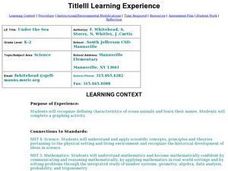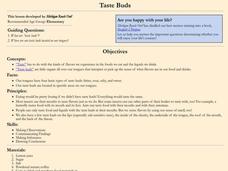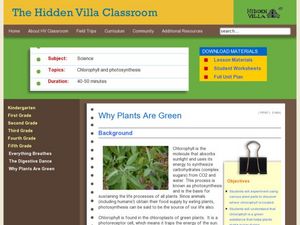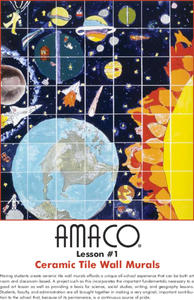Curated OER
Earth & Space Science: Holding it Together
Pupils estimate how many drops of water can fit onto the surface of a penny and then test their hypothesis to find out. They also experiment with bubbles.
Curated OER
Cruzin' to the Arctic
Students, in groups, study life in the Arctic Region and connect their own life experiences to the experiences of students in the Arctic.
Curated OER
Natural Disasters: An Adventure in Non-Fiction
Students study different natural disasters. In this natural disaster lesson students read a nonfiction book followed by a discussion, an experiment, then collect illustrations from their experience.
Curated OER
Boston Harbor Cruise: A Shoreline Survey
The students take a harbor cruise, photograph, and draw shore line features attending to evidence of human impact/consequences, and its cost on marine/land animal habitats vegetation, weather patterns, signs of erosion, and the water...
Curated OER
Colors
Students learn about the Impressionist painters' use of color and how it connected to early nineteenth century scientific theories about color. For this colors lesson plan, students explore combinations of primary and secondary colors,...
Curated OER
How Does a Green Plant Grow?
Students of all ages can explore the question "how do seeds grow?", design an experiment to answer the question, predict the outcome of the experiment then conduct the experiment.
Curated OER
Under the Sea - Ocean Mammals/Fish
Learners explore the similarities and differences between ocean mammals and fish. The characteristics of the life forms observed are placed onto a graph. The classroom becomes the botom of the sea and is explored to gain the required data.
Curated OER
Where are the Dinosaurs?
Young scholars construct their own diorama based on the life of a dinosaur. In this dinosaur lesson, students create models of dinosaurs and dinosaurs' eggs to explore the life cycle of this extinct species.
Curated OER
Taste Buds
Students investigate taste buds. In this taste buds lesson, students identify the four basic taste buds and their locations on our tongue. Students participate in an experiment to investigate how our taste buds work.
Curated OER
Why Plants Are Green
Young scholars discover the properties of chlorophyll in plants. In this plant biology lesson, students conduct an experiment to find where the chlorophyll in the plant is located. Young scholars are split into small groups and study...
Curated OER
We're All In This Together
Students discover what a coral reef is and the animals that live there. In this ecosystem lesson, students act out a story with ocean organisms. They answer questions that show the interdependency of the sea animals.
Curated OER
Digging Detectives
Students experience exploring an archaeological site utilizing various archaeological methods and techniques to help them synthesize multiple aspects of past life and culture to today. They explore what an archaeologist can learn from an...
Curated OER
Bird Bodies
Students read about and explore the different types of birds. They discuss how all birds are alike and what makes some different from the others. They experiment picking up "food items" using different tools that represent different...
Curated OER
Spiders
Students experience the life a spider through several cross-curriculum activities that address multiple learning styles. In this cross-curriculum lesson, students listen to The Very Busy Spider by Eric Carle and toss string in a circle...
Curated OER
Case of the Missing Pumpkin
Students explore the process of decomposition. In this science lesson, students carve a pumpkin and observe as it decomposes. Students compare the changes to an uncarved pumpkin. Students write about the disappearing pumpkin.
Curated OER
Rocks and Soils
Learners compare the properties of rocks and relate these properties to their use. They perform a virtual experiment to describe and group rocks on the basis of their characteristics.
Alabama Learning Exchange
The Five Senses: How They Relate to our World
Students explore the five senses and the significance of each sense. In this five senses and diversity lesson, students listen to You Can't Smell a Flower With Your Ear by Joanna Cole and take a walk observing opportunities to use all...
American Art Clay Co., Inc.
Ceramic Tile Wall Murals
Science, social studies, language arts, and art classes work together with administrators to produce a permanent, ceramic tile wall mural to install at their school.
Space Awareness
What is Time?
Does it ever seem like time is slipping through your fingers? Model the passing of time with an hourglass activity in which individuals determine whether hourglasses are the most efficient way to measure time.
Curated OER
Birth, Growth, And Development
Students understand that all living things have a life cycle that includes being born, developing into an adult, reproducing, and eventually dying.
Curated OER
How Does Whale Blubber Work?
Students perform an experiment to find out how whale blubber keeps whales warm in cold temperatures. They use Ziploc bags lathered in shortening to simulate whale blubber. They put their hands in cold water, both with and without the bags.
Curated OER
Investigating Brass Instruments and Pitch
Students observe the sounds of different brass instruments in order to understand how to create different pitches. In this musical instructional activity, students create a "brass" instrument from everyday household objects. The students...
Curated OER
Finding, Gathering, Saving Seeds
Learners understand the importance of saving seeds. In this saving seeds lesson, students dry out seeds for later use planting. Learners recognize that one plant may have many seeds.
Washington Office of Superintendent of Public Instruction
Using Our Senses to Observe
Look around and explore. Little ones use their five senses with some day-to-day activities designed to guide observation and apply STEM strategies. Young scientists learn through comparing/contrasting and...






















